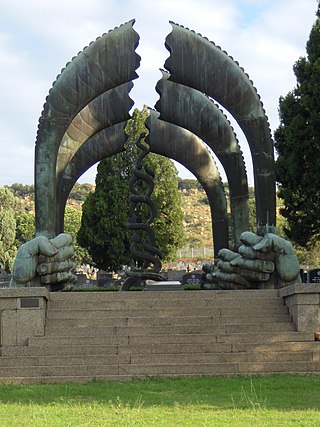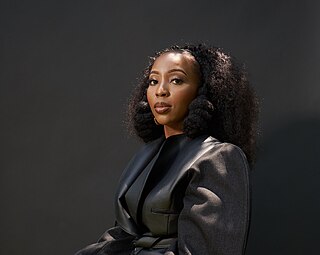Related Research Articles
David Goldblatt HonFRPS was a South African photographer noted for his portrayal of South Africa during the period of apartheid. After apartheid had ended he concentrated more on the country's landscapes. What differentiates Goldblatt's body of work from those of other anti-apartheid artists is that he photographed issues that went beyond the violent events of apartheid and reflected the conditions that led up to them. His forms of protest have a subtlety that traditional documentary photographs may lack: "[M]y dispassion was an attitude in which I tried to avoid easy judgments. . . . This resulted in a photography that appeared to be disengaged and apolitical, but which was in fact the opposite." He has numerous publications to his name.
Guy Tillim is a South African photographer known for his work focusing on troubled regions of Sub-Saharan Africa. A member of the country's white minority, Tillim was born in Johannesburg in 1962. He graduated from the University of Cape Town in 1983, and he also spent time at the Market Photo Workshop in Johannesburg. His photographs and projects have been exhibited internationally and form the basis of several of Tillim's published books.
Zanele Muholi is a South African artist and visual activist working in photography, video, and installation. Muholi's work focuses on race, gender and sexuality with a body of work that dates back to the early 2000s, documenting and celebrating the lives of South Africa's Black lesbian, gay, transgender, and intersex communities. Muholi is non-binary and uses they/them pronouns, explaining that "I'm just human".

Westpark Cemetery is a large cemetery in Johannesburg, South Africa, and is the resting place of some of the country's well-known citizens. It is a non-denomination designated burial ground, and thus has Christian, Jewish, Muslim and Chinese burial areas. The Jewish section contains a Holocaust Memorial, erected in 1959.
William John Monk was a South African, known for his photographs of a Cape Town nightclub between 1967 and 1969, during apartheid. In 2012 a posthumous book was published, Billy Monk: Nightclub Photographs.
Graeme Williams is a South African photographer known for both his photojournalism during the transition to democracy in South Africa and his documentary projects post-apartheid.
Gideon Mendel is a South African photographer, based in London. His work engages with contemporary social issues of global concern. It was his work as a 'struggle photographer' during the final years of apartheid in the 1980s that first brought attention to his work.
Cedric Nunn is a South African photographer best known for his photography depicting the country before and after the end of apartheid.

Gille de Vlieg is a photographer and anti-apartheid activist. She was born in England and moved to South Africa with her mother when she was 3 years old. During apartheid she was a member of both the Black Sash and one of the few women members of the Afrapix photography collective. Her images have been published in newspapers, magazines and books nationally and internationally. Unlike many of her counterparts, de Vlieg received little public acclaim for her work up until recently. About her work, she says, "I wanted to make a contribution to an alternative view of South Africa, a view not seen on the South African TV screen then." Her images cover the following topics: land removals, rural lifestyle, township lifestyle, gender lifestyle, United Democratic Front (UDF), anti-harassment campaign, police violence, protests against death penalty, funerals, Black Sash, protests against incorporation into Bophuthatswana; Release Mandela Campaign, End Conscription Campaign (ECC), conscientious objectors, African National Congress (ANC) Welcome Home Rally, Day of the Vow (Geloftedag), street children, and homeless people.
Eric Miller is a professional photographer based in South Africa. Miller was born in Cape Town but spent his childhood in Johannesburg. After studying psychology and working in the corporate world for several years, Miller was driven by the injustices of apartheid to use his hobby, photography, to document opposition to apartheid by becoming a full-time photographer.
Nontsikelelo "Lolo" Veleko is a South African photographer most noted for her depiction of black identity, urbanisation and fashion in post-apartheid South Africa.
Afrapix was a collective agency of amateur and professional photographers who opposed Apartheid in South Africa and documented South Africa in the 1980s. The group was established in 1982 and dissolved itself in 1991.
Photography in South Africa has a lively culture, with many accomplished and world-renowned practitioners. Since photography was first introduced to the Cape Colony through the colonising powers, photography has variously been used as a weapon of colonial control, a legitimating device for the apartheid regime, and, in its latest incarnation, a mechanism for the creation of a new South African identity in the age of democracy, freedom and equality.

Neo Ntsoma is a South African photographer known for her photojournalism, portraiture, music and popular culture photography. Born in Vryburg and brought up in the rural areas of Mafikeng in the North West Province, her fascination about films was triggered at an early age. Growing up in the apartheid era and seeing the negative portrayal images of black South Africans and the lack of participation of black women in a media industry dominated by white males, this reinvigorated her to want to make change, however it was not an easy dream to fulfill due to race restrictions at the time. Ntsoma attended St Mary's High School where she would be introduced to music, dance and drama, this is where she knew her career path was different from her peers. Despite several setbacks throughout her life she kept on pursuing her dream of being a photographer and succeeded. Ntsoma is known for her photographs that stand out for the odd angles from which they are taken and the way she plays with what is in focus in the photos and what is not. Besides being a photographer she has become an enthusiastic mentor for young photojournalists.

Darcy Marie Padilla is an American narrative photographer and photojournalist who specializes in long-term narrative projects centering on social issues such as urban poverty, drug addiction and HIV/AIDS. She was a Guggenheim Fellow and the recipient of a W. Eugene Smith Award and three World Press Photo awards. She is best known for "The Julie Project" and its related series "Family Love", which both follow an impoverished young woman from 1993 until her death in 2010. Padilla has been a faculty member at University of Wisconsin–Madison since 2018.

Jo Ractliffe is a South African photographer and teacher working in both Cape Town, where she was born, and Johannesburg, South Africa. She is considered among the most influential South African "social photographers."

Ruth Seopedi Motau is a South African photographer currently living and working in Johannesburg, South Africa. Motau was the first black female photographer who was employed by a South African newspaper as photo editor. Her photography focuses on social documentary influenced by photojournalism and the marginalisation of black people and communities.
Thabiso Sekgala was a South African photographer. His work was about "land, peoples’ movement, identity and the notion of home". Sekgala's photography was published in a book, Paradise (2014) and exhibited posthumously at the Hayward Gallery in London.

Lebohang Kganye is a South African visual artist living and working in Johannesburg. Kganye is part of a new generation of contemporary South African artists and photographers born shortly before or after Apartheid ended.
Phumzile Khanyile is a South African photographer, living in Johannesburg. Her series Plastic Crowns is about women's lives and sexual politics. The series has been shown in group exhibitions at the Palace of the Dukes of Cadaval in Evora, Portugal; Iziko South African National Gallery in Cape Town; and the National Gallery of Victoria in Melbourne, Australia; and was a winner of the CAP Prize for Contemporary African Photography,
References
- ↑ Sassen, Robyn (31 December 2011). "Obituary: Gisèle Wulfsohn: indomitable spirit – Times LIVE". timeslive.co.za. Archived from the original on 13 October 2013. Retrieved 20 July 2020.
- 1 2 3 "Gisèle Wulfsohn Mentorship in Photography". The Market Photo Workshop. Retrieved 18 July 2020.
- 1 2 3 Wienand, Annabelle (January 2012). "Portraits, publics and politics: Gisele Wulfsohn's photographs of HIV/AIDS, 1987–2007" (PDF). Kronos. 38 (1): 177–203. eISSN 2309-9585. ISSN 0259-0190. OCLC 860069539.
- ↑ "Obituary: Gisèle Wulfsohn: indomitable spirit". Times Live. 31 December 2011. Retrieved 23 May 2013.
- ↑ "Afrapix timeline 1978 – 1991 | South African History Online". www.sahistory.org.za. 21 March 2011. Archived from the original on 25 March 2019. Retrieved 18 July 2020.
- 1 2 3 Ludman, Barbara. "Gisèle Wulfsohn: A self-portrait of courage". The M&G Online. Retrieved 25 March 2019.
- ↑ Ewing, Deborah. (1995). Guide to local government elections : North-West Province : a training manual. Durban: Y Press. pp. Imprint. ISBN 1-875094-02-4. OCLC 1046477442.
- 1 2 "Gisele Wulfsohn | South African History Online". Sahistory.org.za. 8 September 2011. Retrieved 5 October 2013.
- 1 2 "Gisèle Wulfsohn: A self-portrait of courage | In The Paper | Friday | Mail & Guardian". Mg.co.za. Retrieved 5 October 2013.
- ↑ "Then and Now - Gisèle Wulfsohn". Archived from the original on 24 July 2014. Retrieved 26 October 2013.
- ↑ "Rise and Fall of Apartheid: Photography and the Bureaucracy of Everyday Life". International Center of Photography. 23 February 2016. Retrieved 25 March 2019.
- ↑ "My HIV/AIDS photo journey – Gisele Wulfsohn". Archived from the original on 29 October 2013. Retrieved 26 October 2013.
- ↑ "Soft Walls - A solo exhibition by Gisèle Wulfsohn Mentorship in Photography recipient Sydelle Willow Smith – News – Market Photo Workshop". Archived from the original on 22 February 2014. Retrieved 5 February 2014.
- ↑ "News – The Market Photo Workshop". Marketphotoworkshop.co.za. Retrieved 25 March 2019.
- ↑ "The Usual Suspect is creative storytelling | the Citizen". Archived from the original on 11 September 2015. Retrieved 30 July 2015.
- ↑ ART AFRICA (6 August 2015). "'The Usual Suspect:' In Conversation with Siphosihle Mkhwanazi". YouTube . Retrieved 25 March 2019.
- ↑ "2015 Gisèle Wulfsohn Mentorship in Photography Recipient – News – Market Photo Workshop". Archived from the original on 10 March 2016. Retrieved 9 March 2016.
- ↑ "Plastic Crowns : A solo exhibition by 2015 Gisèle Wulfsohn Mentorship Recipient Phumzile Khanyile" (PDF). S3.amazonaws.com. Retrieved 25 March 2019.[ permanent dead link ]
- ↑ "CAP Prize 2018 – Winners". Capprize.com. Retrieved 25 March 2019.
- ↑ "Exhibition opening: Slaghuis II by 2019 Gisèle Wulfsohn Mentorship in Photography Recipient Thembinkosi Hlatshwayo – The Market Photo Workshop Slaghuis II". The Market Photo Workshop. 20 February 2020. Retrieved 18 July 2020.
- ↑ "Exhibitions - Wits University".
- ↑ https://www.dailymaverick.co.za/article/2022-11-14-gisele-wulfsohns-photographs-at-the-wits-art-museum-a-humane-eye-on-the-terror-years/